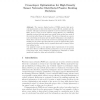Free Online Productivity Tools
i2Speak
i2Symbol
i2OCR
iTex2Img
iWeb2Print
iWeb2Shot
i2Type
iPdf2Split
iPdf2Merge
i2Bopomofo
i2Arabic
i2Style
i2Image
i2PDF
iLatex2Rtf
Sci2ools
ADHOCNOW
2004
Springer
2004
Springer
Cross-Layer Optimization for High Density Sensor Networks: Distributed Passive Routing Decisions
Abstract. The resource limited nature of WSNs require that protocols implemented on these networks be energy-efficient, scalable and distributed. This paper presents an analysis of a novel combined routing and MAC protocol. The protocol achieves energy-efficiency by minimizing signaling overhead through state-less routing decisions that are made at the receiver rather than at the sender. The protocol depends on a source node advertising its location and the packet destination to its neighbors, which then contend to become the receiver by measuring their local optimality for the packet and map this into a time-to-respond value. More optimal nodes have smaller time-to-respond values and so respond before less optimal nodes. Our analysis focuses on the physical layer requirements of the system and their effects of different system parameters on per hop delay and total energy used. Some examples of mappings are examined to obtain analytical results for delay and probability of collision....
ADHOCNOW 2004 | Optimal Nodes | Protocol Achieves Energy-efficiency | Time-to-respond Values | Wireless Networks |
| Added | 30 Jun 2010 |
| Updated | 30 Jun 2010 |
| Type | Conference |
| Year | 2004 |
| Where | ADHOCNOW |
| Authors | Primoz Skraba, Hamid K. Aghajan, Ahmad Bahai |
Comments (0)

